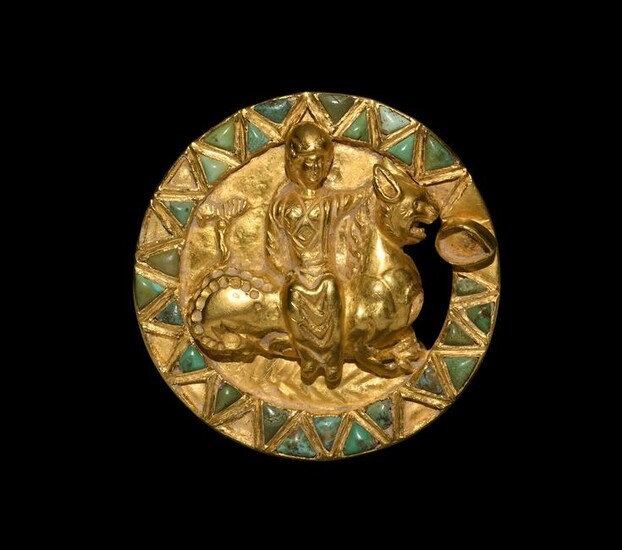Sarmatian Gold Goddess Riding Leocampus Mount
Late 1st millennium BC. A gold 'Sarmatian Animal Style' disc mount with band of inset turquoise triangular inserts to the rim; a goddess, possibly Artemis, riding sidesaddle on the back of a leocampus with its fish-tail raised and mouth gaping, piriform cell before the face; four loops to the reverse. 74.41 grams, 64mm (2 1/2"). Property of a London gentleman; previously acquired on the UK art market in the 1990s; accompanied by an independent specialist report and valuation by graduate gemmologist and jewellery expert Anna Rogers, GIA GG, BA, Gem-A, ref. no.163592/1/9/2020; this lot has been checked against the Interpol Database of stolen works of art and is accompanied by AIAD certificate number no.163592-10059. LiteratureThe term 'Sarmatian Animal Style' first suggested by Prof. M. Rostovtzeff in 1920’s to make it distinct from the well-known Scythian Animal Style. Rostovtzeff described “Sarmatians” as new Iranian-speaking people, who came to the Northern Black Sea region from the east, apparently from the northern boundaries of ancient Bactria, and subdued the Scythians. The most distinctive feature of the style is the polychromy produced by the colour inlays. The majority of depicted figures are fantastic beasts of prey with bodies constructed from different parts of animals, usually shown as symbolic antagonists, representing different parts of the universe; also cf. 'Mistress of Animals' plaque in Hampe, R. and Simon, E., The Birth of Greek Art. From the Mycenaean to the Archaic Period, Fribourg, 1981, pl.354, for type.The leocampus was a mythical beast with the foreparts of a lion and the tail of a fish. It appears infrequently but is represented on a mosaic at the Baths of Neptune, Ostia, Italy. Artemis was the goddess of the hunt, the wilderness, wild animals, the moon, and chastity. Her worship was widespread in Greece and in the colonies such as Ephesus in modern Turkey. In Greek Archaic art she appears as Potnia Theron ('Mistress of the Animals'), a winged goddess holding beasts in her hands, such as a stag, eagle or lion. [A video of this lot is available on TimeLine Auctions website]
Condition Report: Fine condition.
Sale price
Estimate
Time, Location
Auction House
Late 1st millennium BC. A gold 'Sarmatian Animal Style' disc mount with band of inset turquoise triangular inserts to the rim; a goddess, possibly Artemis, riding sidesaddle on the back of a leocampus with its fish-tail raised and mouth gaping, piriform cell before the face; four loops to the reverse. 74.41 grams, 64mm (2 1/2"). Property of a London gentleman; previously acquired on the UK art market in the 1990s; accompanied by an independent specialist report and valuation by graduate gemmologist and jewellery expert Anna Rogers, GIA GG, BA, Gem-A, ref. no.163592/1/9/2020; this lot has been checked against the Interpol Database of stolen works of art and is accompanied by AIAD certificate number no.163592-10059. LiteratureThe term 'Sarmatian Animal Style' first suggested by Prof. M. Rostovtzeff in 1920’s to make it distinct from the well-known Scythian Animal Style. Rostovtzeff described “Sarmatians” as new Iranian-speaking people, who came to the Northern Black Sea region from the east, apparently from the northern boundaries of ancient Bactria, and subdued the Scythians. The most distinctive feature of the style is the polychromy produced by the colour inlays. The majority of depicted figures are fantastic beasts of prey with bodies constructed from different parts of animals, usually shown as symbolic antagonists, representing different parts of the universe; also cf. 'Mistress of Animals' plaque in Hampe, R. and Simon, E., The Birth of Greek Art. From the Mycenaean to the Archaic Period, Fribourg, 1981, pl.354, for type.The leocampus was a mythical beast with the foreparts of a lion and the tail of a fish. It appears infrequently but is represented on a mosaic at the Baths of Neptune, Ostia, Italy. Artemis was the goddess of the hunt, the wilderness, wild animals, the moon, and chastity. Her worship was widespread in Greece and in the colonies such as Ephesus in modern Turkey. In Greek Archaic art she appears as Potnia Theron ('Mistress of the Animals'), a winged goddess holding beasts in her hands, such as a stag, eagle or lion. [A video of this lot is available on TimeLine Auctions website]
Condition Report: Fine condition.



